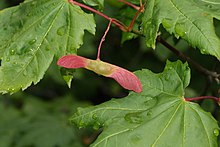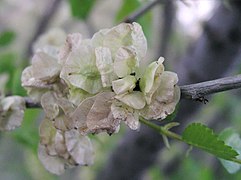Samara (fruit)


A samara (/səˈmɑːrə/, UK also: /ˈsæmər-/)[1] is a winged achene,[2] a type of fruit in which a flattened wing of fibrous, papery tissue develops from the ovary wall. A samara is a simple dry fruit, and is indehiscent (not opening along a seam). The shape of a samara enables the wind to carry the seed farther away from the tree than regular seeds would go,[3] and is thus a form of anemochory.
In some cases the seed is in the centre of the wing, as in the elms (genus Ulmus), the hoptree (Ptelea trifoliata), and the bushwillows (genus Combretum). In other cases the seed is on one side, with the wing extending to the other side, making the seed autorotate as it falls, as in the maples (genus Acer) and ash trees (genus Fraxinus).[4]
There are also single-wing samara such as mahogany (genus Swietenia) which have a shape that enables fluttering.
Some species that normally produce paired samaras, such as Acer pseudoplatanus, can also produce them in groups of three or four.[5]
-
Unusual group of three samaras of sycamore maple (Acer pseudoplatanus. Normally, they are in pairs.)
-
Seeds of the tropical ash (Fraxinus uhdei)
-
The hoptree (Ptelea trifoliata)
-
The Siberian elm (Ulmus pumila)
In culture
[edit]A samara is sometimes called a key[2] and is often referred to as a wingnut, helicopter, whirlybird, whirligig, polynose, or, in the north of England, a spinning jenny.[6] During the autumn months, they are a popular source of amusement for humans, who enjoy tossing them in the air and watching them spin to the ground.
References
[edit]- ^ "samara". Oxford English Dictionary online edition. Oxford University Press. Retrieved 30 July 2018.
- ^ a b Gray, Asa (1875). Botany for young people and common subjects : how plants grow : a simple introduction to structural botany : with popular flora, or an arrangement and description of common plants, both wild and cultivated : illustrated by 500 wood engravings. Fisher - University of Toronto. New York : Ivison, Blakeman, Taylor. p. 79.
- ^ Fergus, Charles (2002-01-01). Trees of Pennsylvania and the Northeast. Stackpole Books. ISBN 9780811720922.
- ^ Alexander, David E.; Vogel, Steven (2004-10-13). Nature's Flyers: Birds, Insects, and the Biomechanics of Flight. JHU Press. ISBN 9780801880599.
- ^ Niklas, Karl J. (1992-08-01). Plant Biomechanics: An Engineering Approach to Plant Form and Function. University of Chicago Press. ISBN 9780226586304.
- ^ "Seed dispersal by wind: Gone with the wind - Woodland Trust". www.woodlandtrust.org.uk. Retrieved 2016-03-15.
Further reading
[edit]- Spinning Flight : Dynamics of Frisbees, Boomerangs, Samaras and Skipping Stones, Ralph Lorenz, Copernicus New York, September 2006 ISBN 0-387-30779-6




